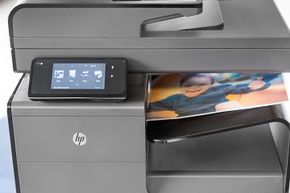Inkjet and Laser Printer Functionality
The two printers that are most widely available and cost-effective for home and typical office use are inkjet and laser printers.
Inkjet printers spray liquid ink onto paper in tiny, precise drops. The ink is held in replaceable or refillable cartridges, most of which include a print head with an array consisting of hundreds or thousands of tiny nozzles through which the ink is sprayed, and which are arranged close together. Some printers have built-in printer heads that are separate from the color cartridges. The cartridges also include microchips and other tiny electronic components to control the ink spray and may include hydrophobic foam that holds the ink. These printers usually use either thermal technology (using tiny chambers of ink that heat up) or piezoelectric crystals (which vibrate or change shape when charged) to propel tiny ink droplets onto a page to create the printed text or images. A printer arm moves the cartridges across the page as the images are drawn. Software algorithms that interpret the computer image you are trying to print determine the color and position of the ink that makes it to the page.
Advertisement
The ink in a typical inkjet printer includes black plus three primary colors with which all the other printable colors are made through blending. These primary colors are cyan (blue), magenta (a reddish color) and yellow. Black ink is usually in its own cartridge. For some printers, the other colors are housed in a single cartridge, while for others, each color has its own separate cartridge.
Inkjet printers can print on a wide variety of media, including various weights of paper and specialized materials like iron-on transfers, cloth, canvas, transparencies, and CD or DVD labels. There are inkjet printers dedicated entirely to printing photographs on special photo paper, some of which have more than the three primary colors for more photorealistic color possibilities.
Laser printers use powdered toner made of tiny particles of colored plastic rather than liquid ink. Lasers project an image onto a rotating drum or belt coated in a photosensitive material, changing the charge in those areas. The toner is charged with static electricity of the opposite polarity, and when the drum is rolled through the toner, the toner is attracted to the image area created by the laser. The toner-covered drum is pressed onto a sheet of paper, which has a charge opposite to that of the toner applied to it so that the toner is then attracted to the paper. The paper is heated and pressed through rollers so that the toner melts and the image fuses to the paper. LED printers work similarly but use arrays of light-emitting diodes instead of moving lasers to project the image onto the drum. Most home-use laser printers are monochrome, but color laser printers exist, and they usually have a separate drum and cartridge for each color (black, cyan, magenta and yellow).
The various home and office printers also come with a variety of different functions. They handle various sizes and types of paper and other media. One that prints on wider paper, such as poster-sized, will be more expensive than the typical ones that mainly print on standard letter-size paper. Some also include duplexing (printing on both sides of the page). And many now have WiFi and cloud capabilities so you can send pages to the printer wirelessly. There are also a lot of multi-function devices on the market that act as printers, scanners, copiers and fax machines in one.
